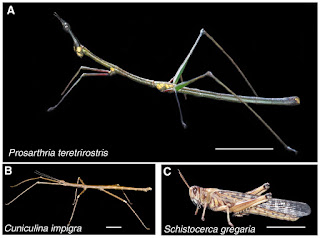And God said, Let the earth bring forth the ...creeping thing,...
Genesis 1:24
"An international group of scientists, publishing in the journal Science, studied stick insects—those long, skinny walking insects that try to blend in with plants by mimicking twigs. In their paper, “Natural selection and the predictability of evolution in Timema stick insects,” they do their best to estimate the trajectory of these bugs. Laura Zahn, however, in a summary of the paper in the same issue of Science, has this to say:
Evolution results from expected effects, such as selection driving alleles toward fixation, and stochastic effects, such as unusual environmental variation and genetic drift. To determine the potential to predict evolutionary change, Nosil et al. examined three naturally occurring morphs of stick insects.
They wanted to determine which selective parameters could be used to foresee changes, despite varying environmental conditions. One morph fit a model of negative frequency-dependent selection, likely owing to predation, but changes in other morph frequencies remained unpredictable. Thus, for specific cases, we can forecast short-term changes within populations, but evolution is more difficult to predict when it involves a balance between multiple selective factors and uncertainty in environmental conditions.According to Zach Gompert at Utah State University, one of the authors, the predictability is hardly surprising: brown stick insects would be found on brown plants, and green stick insects would be found on green plants. The reason is that birds can more easily see the out-of-place morphs and eat them. This explains why out-of-place insects would be missing, but says little about the arrival of the camouflaged species. A USU press release says that the team analyzed 25 years’ worth of data to try to figure out if evolution is predictable.
“With the green versus green-striped morphs, the cause of selection was simple and well understood facilitation of predictability,” Gompert says. “In contrast, with the melanistic morph, natural selection was more complex and tied to variation in weather and climate, making it harder to predict from past patterns of change.”
The scientists compared their results to better known studies, including Darwin’s finches and the scarlet tiger moth, both of which were also not very predictable.
“Our findings support previous discoveries and suggest evolution of morph frequencies in these stick insects is indeed a result of selection,” Gompert says. “They also suggest poor predictability of environmental variation and how it affects selection, rather than random evolutionary processes, might be the main limits on predicting evolution.”
While we can use the past to predict change, he says, we’re constrained by our lack of knowledge of the future and complex ecological processes that contribute to change."
It’s hard to characterize any of this data support for evolution being predictable. They’re basically saying, ‘evolution is predictable except when it isn’t.
So the environment is unpredictable, selection is unpredictable, and mutations are clearly random. Adding three random factors together does not improve on randomness." CEH

